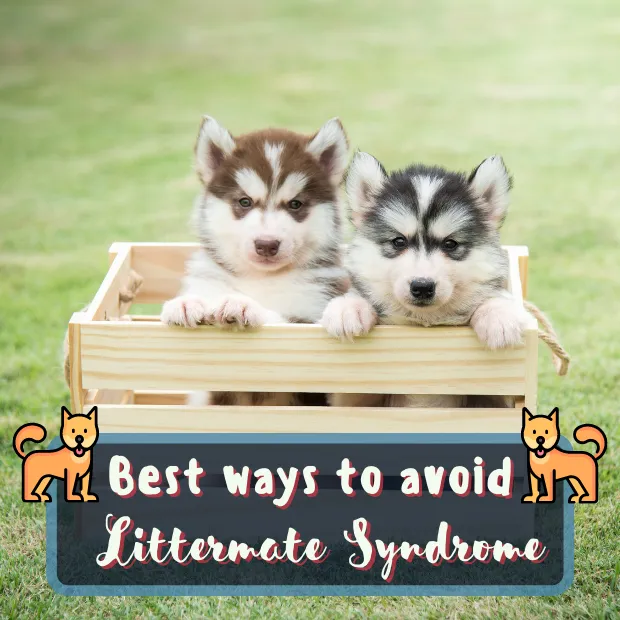If you’re a dog owner, there’s a chance you’ve heard of “littermate syndrome.” This is when two or more dogs who are raised together form an especially close bond and which can lead to behavioral problems. In some cases, this can even lead to one dog attacking another.
If you’ve got 2 puppies with less than a one year age gap, your dogs are in danger of developing littermate syndrome, regardless of whether or not they’re related.
So, how can you avoid littermate syndrome in your own dogs? Here’s my top tips as a qualified trainer on the best ways to avoid littermate syndrome.
Table of Contents
ToggleContents of this article:
- Don’t treat them like one dog with 8 legs.
- Separate your dogs as much as possible.
- Invest in a dog crate for each puppy.
- Never make them share a crate.
- Take your littermate puppies on separate walks.
- Enroll your puppies in separate training classes.
- Make sure to praise each dog equally.
- Encourage individual behavior.
- Be aware of body language.
- Never force them to interact.
- Conclusion – Best ways to avoid littermate syndrome.
Don’t treat them like one dog with 8 legs.
Make sure each dog has their own food bowl, toys, bones, chews, and bed. At our house, we even go as far as having multiple water bowls in different spots in the kitchen. Don’t make them share anything as this can cause resource guarding and easily lead to fights.
Separate your dogs as much as possible.
This means having two different feeding areas, two different sleeping areas, and two different play areas.
Invest in a dog crate for each puppy.
If possible, get two separate crates so that your puppies can have their own space to retreat to when they need some time away from their littermate. This will help them to avoid feeling overwhelmed and stressed out.
If you do not have space for crates in separate areas, make sure there is a visual barrier between the crates, such as a blanket draped over one or both crates, or a piece of board between them. This will help to prevent them becoming reliant upon having their sibling within sight to settle.
Never make them share a crate.
Just like people, not every dog wants to spend 24/7 with their best friend. Make sure to schedule some solo time for each puppy so that they can recharge their batteries.
This is especially important if one puppy is more high energy than the other. Dogs need time to be alone, away from their littermate, to de-stress and relax. We all need time to ourselves.
Take your littermate puppies on separate walks.
I know it’s easier and more fun to take them both out at the same time, but this is one of the quickest ways to develop littermate syndrome.
Instead, make it a habit to take them out one at a time so that they each get your undivided attention. If you can’t do this, then make sure to give each dog equal amounts of attention on walks.
Enroll your puppies in separate training classes.
This is essential for socialization and will help to avoid any competition between the two dogs. This is usually where I see the first signs of littermate syndrome.
We have a rule of one dog per handler for classes, so if littermates are attending, they must each have their own handler.
When we separate the puppies and put them at opposite ends of the class, there is often one who spends the majority of the time seeking their littermate and they can’t focus on their handler.
They are often very closely bonded to their littermate by 14-16 weeks, at the detriment of the relationship with their owner.
Make sure to praise each dog equally.
If you find yourself praising one dog more than the other, you’re inadvertently encouraging competition between them.
So, whenever possible, make sure to praise both dogs equally for good behavior. This will help to avoid any jealousy or competition between them.
Encourage individual behavior.
Make sure each dog is getting plenty of attention and praise for good behavior, independent of the other.
This means no cuddling or playing with them at the same time – each dog should have their own individual session. If one dog is misbehaving, don’t punish the other – this will only create a sense of rivalry.
Give one dog a self-led activity such as a Lickimat or a stuffed Kong in their crate whilst you interact with the other one.
Be aware of body language.
Dogs communicate a lot through their body language, and you need to be able to interpret this correctly. If one dog is cowering away or seems anxious, there’s a good chance the other is being too rough.
If they’re both constantly trying to get as close to you as possible, they’re probably vying for your attention. Paying close attention to their body language will help you nip any potential problems in the bud.
Never force them to interact.
If one or both of your dogs seem uncomfortable around each other, don’t force them to interact. This will only heighten the tension and could lead to a fight.
Instead, try gradually introducing them to each other in a positive way – for example, by scatter feeding them at the same time with a pet gate or ex-pen between them.
Best Ways to Avoid Littermate Syndrome in Dogs.
Littermate syndrome can become a serious issue, but it can be avoided if you’re aware of the potential dangers and take steps to prevent it. The easiest way to ensure this is by giving each of them more human one-to-one time than they spend together.
Some people think it’s cute when their dogs are “inseparable” and constantly look for one another, but this is a real problem for the wellbeing of both dogs. If one ever needs an overnight stay at the vet or if they need to go to separate places when the owner goes on holiday, this can cause massive distress.
It is better to encourage each dog to be independent of the other and to form a good bond with their owner. Dogs need to be confident without their littermate and should never be overly reliant on them.
Littermate syndrome is a significant behavior problem that can develop in dogs who are less than a year old and have an age gap of less than one year.
The best way to avoid this is to separate your dogs as much as possible, take them on separate walks, enroll them in separate puppy classes, and make sure to praise them equally.
By following these tips, you’ll be giving your dogs the best possible chance of having a happy and healthy relationship.
More articles on littermate syndrome and having two dogs:







